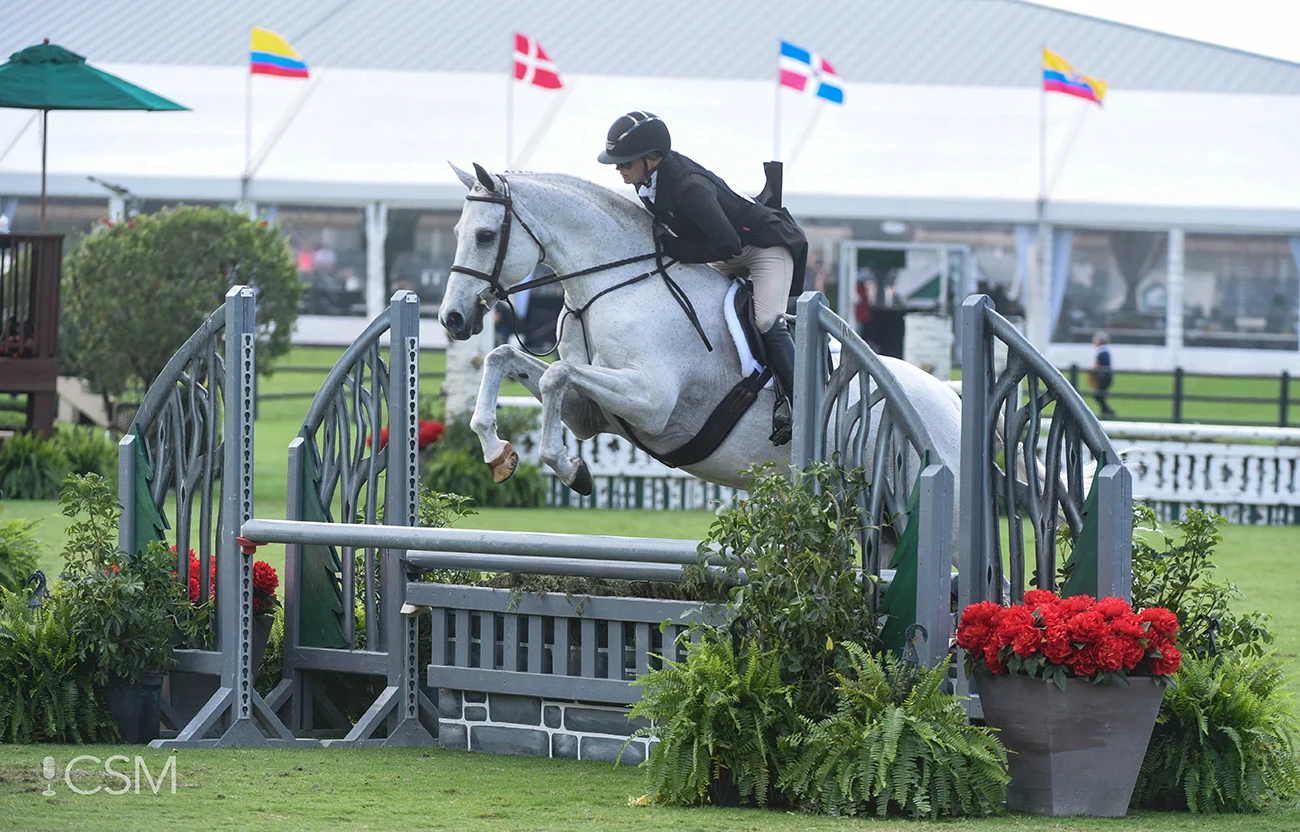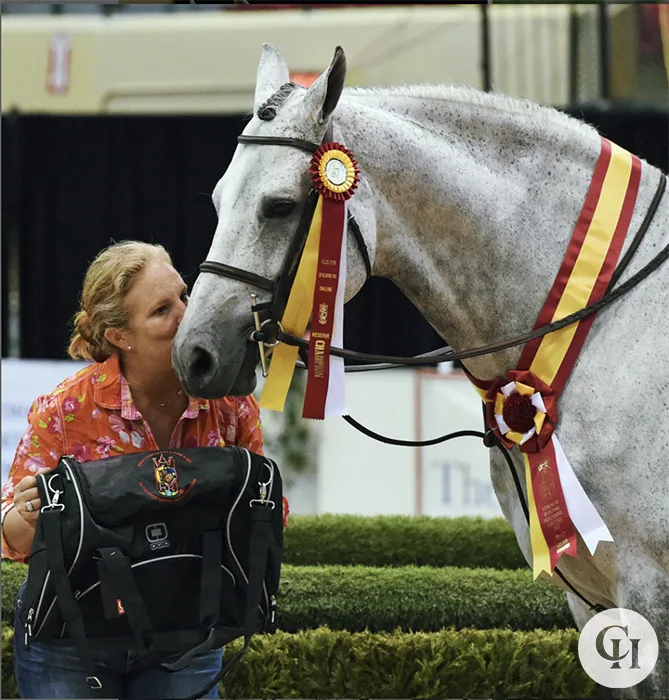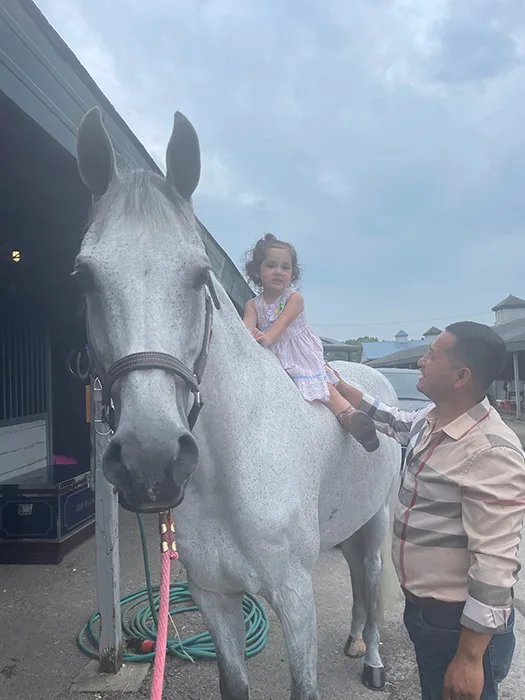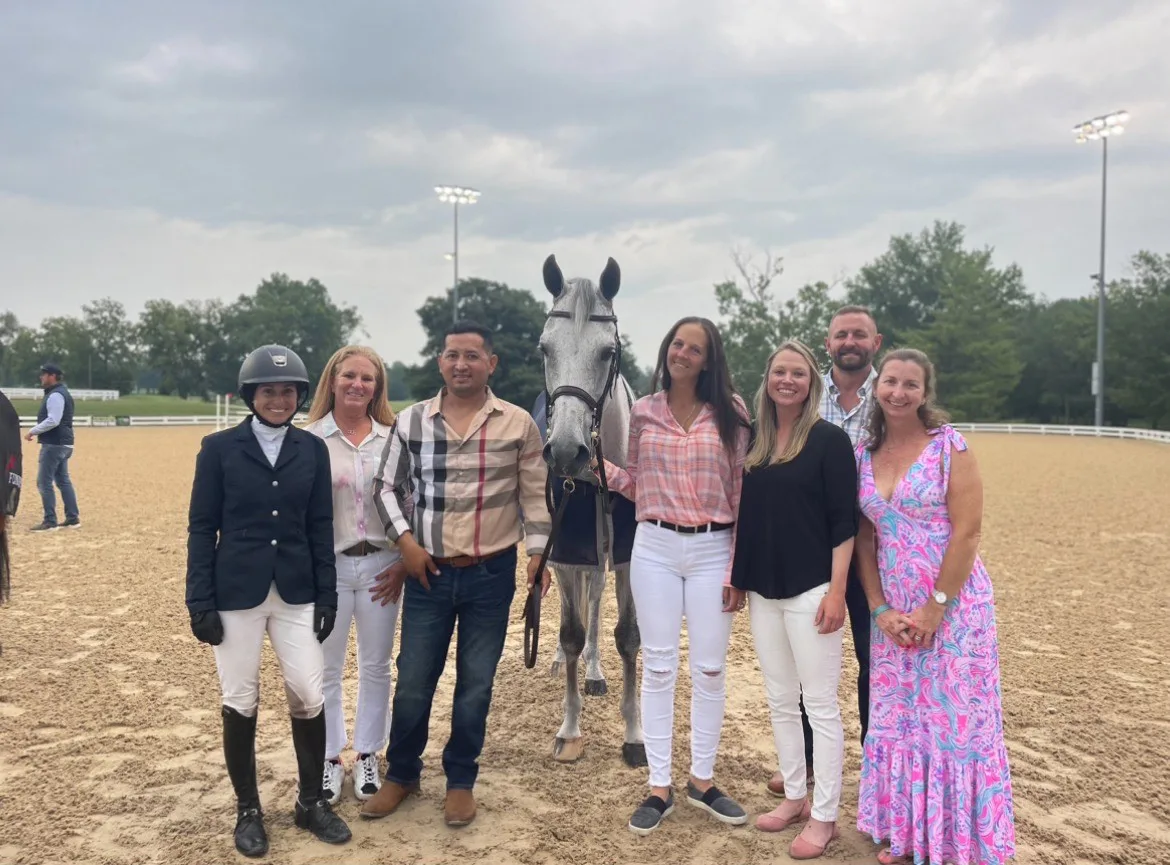ESP Farm’s assistant trainer Molly Allen knew the pressure was on when she saw her head groom, Waldo Cantarero, leading her hunter derby mount Celtic Fire up to the show ring.
“Waldo usually stays back in the barn and sends the other guys up with the horses to the rings,” Allen said. “I knew this was serious; he only comes up for the top horses!”
Allen was slated to go first in the $5,000 USHJA National Hunter Derby at the Deep Run Horse Show (Virginia) on June 23. Although she felt some nerves, Allen had her first round mapped out in her head. Sticking to it paid off; the judges rewarded her with a score of 89. When Allen returned for the handy, she was more conservative through a rollback turn, earning her a 90.5 and overall second place. “When I landed off the last oxer, the crowd around the ring went wild,” she said.
“I’ve never heard that in my life. People I didn’t know were screaming, clapping, coming over to me and telling me how great the round was. It was an amazing feeling that I will never forget.”
Hearing “Fire’s” name in second place brought tears of happiness to trainer and owner Rachel Kennedy’s eyes. All of Fire’s horse show ribbons hold a lot of significance for his team of veterinarians, owners, farriers, grooms, Allen and Kennedy.
“When Fire goes well—just watching him go around—it’s emotional for me,” Kennedy said. “We’ve been through so much with him. We’re so careful with him, and we’re constantly questioning everything with him: Should we longe him today? How’s the footing, et cetera?”

Over the years, the 16-year-old Dutch Warmblood gelding (Vittorio—Mona Liza, Corofino), owned by CF Partners, has encountered several life-threatening setbacks. Kennedy credits his resilience and vitality for life for helping him overcome each.
Kennedy imported Fire as a 9-year-old stallion from trainer Matteo Guinti’s farm in Florence, Italy, in June 2015. Kennedy’s former student Kaitlin Campbell found a video of Fire, who is a half-brother to her grand prix horse, Rocky W, and convinced Kennedy to try the dark gray stallion.
“One of the things that caught my eye was that he was the most beautiful mover,” Kennedy said. “I knew that if he did not turn out to be a grand prix horse then he was going to be a hunter.”
Once Fire was stateside, Campbell showed him in the 1.40- to 1.45-meter jumper classes and grand prix classes. But after a year, Kennedy was skeptical that Fire wanted to continue his career as a jumper.
“The thing about Fire was that he would always have a rail in the first round of the prix, or he’d have a rail in the jump-off,” Kennedy said. “[Top hunter trainer] Larry Glefke of Lane Change Farm was the one who suggested to me that Fire should be a hunter.”
In 2016, Kennedy took Glefke’s advice and gave professional hunter rider Erica Quinn, who worked for Lane Change at the time, the ride on Fire. The pair clicked immediately, making a name for themselves in the professional hunter divisions and USHJA international derbies. They rode to many top placings, including a win in the $50,000 USHJA International Hunter Derby at the 2016 Chicago Hunter Derby, eighth in the 2017 USHJA International Hunter Derby Championship (Kentucky) and second place in the WCHR Developing Professional Challenge Class at the 2017 Capital Challenge Horse Show (Maryland), as well as several Top-10 placings in major derbies.

In autumn 2017, Quinn, Kennedy and Fire were headed to Lexington, Kentucky, for the 2017 National Horse Show off the back of another top derby placing at World Equestrian Center—Ohio when the horse spiked a high fever.
Kennedy called her veterinarian, Kim Bordeleau, DVM, who had cared for Fire since he arrived stateside, to come check him.
“When I saw him, it became quite clear that this was very serious,” Bordeleau said. “We didn’t feel like there was much we could do to help him at the horse show, so we shipped him to the Rood & Riddle Equine Hospital.”
William Gilsenan, VMD, Dipl. ACVIM, a veterinarian at Rood & Riddle (Kentucky), and his team determined Fire was experiencing symptoms of laminitis, the inflammation of the soft tissue structures between the coffin bone and the hoof wall, and he was diagnosed with pneumonia, a lower respiratory tract infection. They immediately started treating him with pain medications and ice for the laminitis and antibiotics to combat the fever. At the time, Fire’s prognosis was grave.
ADVERTISEMENT
“Laminitis can be quite life-threatening, and that’s part of the scare of it,” Bordeleau said. “The horses can turn corners quickly and become so painful in their feet that it’s not compatible with life; they live standing on their legs.”
Fire survived the most acute threat but spent two weeks at Rood & Riddle before being released. Instead of shipping him back to her farm in Brookville, Maryland, Kennedy sent Fire to Lane Change Farm in Lexington, to continue his early recovery. The week of Christmas, Fire was cleared to ship to Wellington, Florida, to rejoin the rest of the ESP Farm horses. But several days after he arrived, Kennedy got a phone call that Fire wasn’t feeling well. He immediately went to Rood and Riddle Equine Hospital’s Wellington location, where veterinarians determined he was experiencing another laminitic episode.
It’s not uncommon for laminitis to “rear its ugly head twice like that,” Bordeleau said, but it sent the horse and his team back to square one. Veterinarians began the complicated task of reducing his fever with antibiotics, icing his feet and trying different therapeutic shoes to make him more comfortable. It was a dire situation again, and they were unable to predict whether Fire would ever be physically comfortable on his feet—let alone compete—again.

In the early days of Fire’s second clinic stay, Kennedy began to notice that there were a lot of veterinarians involved with his case, and she felt it would be better to have a smaller team dedicated to his recovery.
Kennedy found José Bras, DVM, MS, DACVS, the veterinarian who initially treated Fire at the clinic.
“I told him that I only wanted Jose and his twin brother, Raul, to touch Fire from that point on,” she said. “I wanted them to help my horse; I believed in their abilities. At the time, Fire was still a stallion, so if he never was able to compete again, I was OK with it—he could be bred. If he was healthy enough to horse show again, then great. I told them I would give them a year to help Fire.”
When Raul Bras, DVM, CJF, APF, who is an equine podiatrist, arrived in Wellington for his monthly trip, he found the stallion’s name on his schedule.
“Before I was able to look at Fire, several vets had attempted different therapeutic shoes with Fire,” Raul said. “He had not responded to any of these options like he should have, so I had to come up with a different plan.”
Using a Venogram, which uses contrast dye to evaluate the vasculature of the hoof, and radiographs before and after he shod Fire the first time, Dr. Raul analyzed the compromised blood flow in Fire’s feet and designed a modified nail-on rocker shoe for him to wear.
“Blood supply is necessary for hoof growth,” he said. “When you have displacement, sinking and/or rotation of the coffin bone, you compromise the blood supply. I needed to give Fire a shoe that would give him support but would also restore blood flow to his feet. You have to approach each horse differently—their conformation, biomechanics and the discipline they compete in are not the same as another horse.”
He re-evaluated Fire two weeks later.
“When I returned two weeks later and did another Venogram, I couldn’t believe how quickly the blood supply to Fire’s feet had improved; the results were dramatic,” he said. “A typical horse would respond to these new shoes within two to three months; Fire responded within two weeks.”
He waited another six to eight weeks before shoeing Fire again, and the next Venogram confirmed the blood supply was maintaining with the new shoes.
“Many horses, if the approach is correct, can recover from laminitis or founder,” he said. “Good horses overcome the odds, and Fire definitely did.”
Near the end of the Winter Equestrian Festival (Florida) in 2018, Fire was released from the clinic, and Kennedy opted to send him to her friend Sam Alvarado at Marigot Bay in Lexington. Raul lived nearby, and he continued to shoe and monitor Fire’s recovery for the rest of 2018.
On average, it can take anywhere from eight months to a year for a new hoof capsule to grow.
ADVERTISEMENT
“My principle for Fire would change based on his hoof growth and response. I had to trim and evolve the shoe that I was using,” Raul said. “My goal was to slowly de-rotate him so he would have better bone alignment with better function overall.”
Raul continued to use a Venogram while shoeing Fire until he felt the horse had sufficient hoof growth. After that, Fire was shod with only the assistance of radiographs. “By using the Venogram, I was confirming that my thought process and principles were working. I don’t like the ‘wait-and-see’ principle; you can’t use that for a laminitis/founder case. You don’t have time for that.”

Once Fire was cleared to ride, Alvarado started tack walking him. By mid-August, Fire was back at Kennedy’s farm in Maryland, and she regularly sent Raul videos of Fire for assessment as they progressed through his rehab. Kennedy’s farrier, Kevin Oyarzo, also took over Fire’s shoeing.
“I consulted my mentors a lot about Fire to help keep him sound, and I still do,” Oyarzo said. “When I work on Fire, I use different shoes and mechanics specifically for laminitis and adjust them according to the X-rays we take of his feet when he’s shod. I also factor in the environment he’s in, where he’s going to show, what the footing might be like, etc.”
Fire’s first horse show back was at the 2019 Aiken Charity Horse Show I (South Carolina) with Kennedy in the irons; they were reserve champion in the Aiken 3’ hunter division.
“I gave Fire’s ribbons from that show to Kevin and Dr. Raul,” Kennedy said. “From there, it’s been a give and take with Fire. You show him, then you back off a bit, then you repeat. It’s a team effort to keep him sound and comfortable, and he has the best team.”
Since 2020, Allen has had the ride on Fire, and together they have won multiple tricolors at top shows. She hopes to qualify and compete in the Developing Pro Challenge at Capital Challenge.
“He’s one of the kindest horses I’ve ever met,” she said. “I trust him wholeheartedly. Because of everything he has gone through, every day with him is a blessing. I’m so grateful to Rachel and her husband, Oliver, for giving me this opportunity; it’s an incredible feeling that people believe in me that strongly.”
Although Quinn no longer competes on Fire, she still cheers him on from the sidelines.
“Fire is such a special horse to me,” she said. “I love him so much, and I’m happy that his story didn’t end there—he went on and showed again.”

Bordeleau is still very active in caring for Fire and routinely shares videos of his show ring successes with her entire team.
“I love to share that with everyone who played such an important part in his recovery,” she said. “Our team has made this a success story. The most important thing we all do is to listen to Fire. Our goal is the show ring, but if one of us hears Fire say that today’s not the day, then we speak up for him. Rachel has given Fire—and still does—the time he needs to heal, and that has been huge for him.”
Although Kennedy is thrilled with Fire’s recovery, she is pragmatic about his future. Kennedy is very selective with Fire’s annual competition schedule, and she adjusts it according to how Fire feels, even if that means scratching.
“He is the sweetest horse ever,” Kennedy said. “He still jumps right on the trailer to go to the horse show every time. As long as that horse is still having fun and enjoys competing, he will do it. When it’s not fun for him anymore, then we will stop and let Fire retire.”
Do you know a horse or rider who returned to the competition ring after what should have been a life-threatening or career-ending injury or illness? Email Kimberly at kloushin@coth.com with their story.














